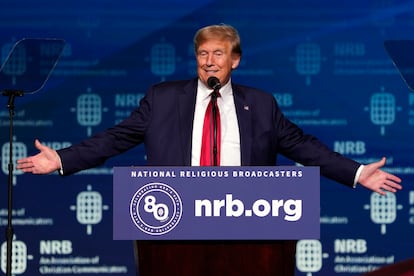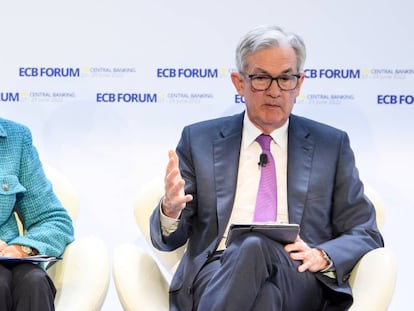A Trump win: A ticking time bomb for the bond market
The former president’s pledge to introduce more tariffs and lower taxes portends more inflation just as the Fed starts considering a cycle of rate cuts

The countdown to the U.S. presidential election in November has begun, and Donald Trump is already the frontrunner to win the Republican nomination. He is also a serious contender to win the White House, a victory that would put Trump — a combative business tycoon who faces four criminal investigations, two of which involve his role in the assault on the U.S. Capitol — back at the helm of the world’s biggest economy. Trump’s return to the White House could lead to further polarization in the United States and upset the fragile play of forces in international politics: he could be an unpredictable political and economic time bomb. His win in the November 2016 election was an unexpected shock for the financial markets, which quickly recovered from their initial losses. Indeed, Trump’s mandate left them a juicy balance of capital gains.
But the possibility of a new Trump administration comes at a very different economic moment. Despite this, the former president’s economic recipe remains the same: lower taxes and more tariffs. This policy would undoubtedly worsen the public debt and deficit problem already afflicting the U.S. economy and that would revive inflationary tensions at the worst possible moment, just when a cycle of rate cuts is expected to reduce the pressure on households and businesses after the most intense rate rises in the last 40 years.
A hypothetical return of Trump to the White House has already put some asset managers on alert, and the financial market is assuming that there will be a rise in volatility in the months leading up to November’s presidential election. Some of the market fears there will be a repeat of what happened in November 2016, when U.S. bond yields soared in the weeks following Trump’s victory. The yield on 10-year bonds rose from 1.8% shortly before the election to 2.65% in mid-December, which was then the sharpest rise in seven years. At the time, the Fed was beginning a rate hike cycle, and had only announced one interest rate rise at the time of the election. Now, the world’s most influential central bank is moving in the opposite direction. It is on the verge of finally curbing inflation and appears set to start lowering rates — provided there are no surprises that hamper this plan.
Echoes of November 2016
In the event of a Trump victory, the DWS asset management group expects that there will be less of an impact on the market than in 2016. According to DWS, the surprise effect would be much less pronounced and the markets would have priced in the scenario, “which is not to say that yields are not likely to rise in general.”
The asset managers point out that Trump has announced that he will raise the tariffs on products imported to the U.S. by 10% and that he will retain the tax cuts he put in place in 2017 — two measures that are “likely to be inflationary.” “This, together with the experiences from Trump’s first term in office, in our opinion provide sufficient arguments for higher yields in the event of his election,” the company adds.
That 10% tariff on imports to the United States is one of Trump’s star measures. It is a big leap from his protectionist policies in 2016, when he imposed tariffs only on products from China, and on specific items such as steel. Pedro del Pozo, the director of financial investments at Mutual, recalls that protectionist policies and tariffs usually fuel inflation. “Given the importance of the United States as the engine of the world, it is possible that these prices could become contagious and rise. This would be very serious, if it were to happen, at a time when inflation is far from contained and rates remain high,” he warns.
Orla Garvey, a fixed-income portfolio manager at Federated Hermes, agrees that if Trump sticks to the script of his last term, “we could expect increased tariffs, with China and Europe apparently in his sights, tax cuts and more potential for fiscal expansion.” She points to an underlying issue that is already dragging down the U.S. economy. “In the current environment of large deficits that need to be financed, this would likely mean that investors would demand more term premium to back U.S. debt,” she warns.
“The U.S. deficit situation is already dire,” notes J. Safra Sarasin Sustainable AM fixed-income strategist Alex Rohner. The Congressional Budget Office warned that if budget policies are not changed in the coming years, America’s debt-to-GDP ratio will grow from 100% to almost 120% by 2033.
Higher public deficits
Trump has promised to lower taxes, but this could lead to higher budget deficits. According to experts, U.S. President Joe Biden would also face this risk if reelected. “If the U.S. public deficit grows, there may be more pressure on interest rates. But the deteriorating fiscal situation forecast for the U.S. economy is expected under both Biden and Trump,” says Ricard Murillo, an economist at CaixaBank Research.
The specter of fiscal deficit is haunting both Democrats and Republicans. The former are under pressure to stop the end of the Affordable Care Act health insurance subsidies, which are set to phase out in 2025, while the Republicans are facing the end of the Trump-era tax cuts, which also expire at the end of next year.
According to estimates by Generali Investments, an agreement that permanently extends the fiscal priorities of both parties could increase the U.S. public deficit by at least $1 trillion through 2033. The Democrats’ policies could widen the deficit when it comes to spending, while the Republicans’ could do so by reducing revenue. That said, Trump’s commitment to raising tariffs may be a differentiator for the bond market. “Democrats are likely to continue to prefer subsidies and regulation, while a Republican administration would likely impose more tariffs on the rest of the world, which would raise inflation,” concludes Paolo Zanghieri, a senior economist at Generali Asset Management.
In any case, and as pointed out by CaixaBank Research, tariffs can also trigger lower growth. “The increase in tariffs would have an inflationary effect and would also be negative for growth. In 2019, in the midst of the trade war during Trump’s term, the Fed cut rates largely because of that trade tension,” explains Murillo.
Relationship with Powell
The candidate who wins the November presidential election will have to appoint a new Federal Reserve chairman. Jerome Powell’s term ends in 2026 and Trump has already stated that, if he comes to power, he would not renew his mandate. What’s more, Trump accused him of planning interest rate cuts to help Biden get reelected.
But the Fed has already announced rate cuts of 75 basis points over the course of this year, so that financial markets, businesses, and consumers can anticipate those cuts and adjust their decisions accordingly. During his term, Trump pressured Powell not to raise rates and, if he wins in November, he will try to push for lower rates, warns Rohner. This would lead to a new arm wrestle for the independence of the world’s most influential central bank.
For the time being, the current economic situation in the United States could favor Biden’s reelection, in the opinion of George Brown, economist at Schroders. “Biden has many reasons to be optimistic about his chances of reelection. In addition to the upside of his current position, he is overseeing a strong economy, a tight labor market and slowing inflation,” he says. However, despite these elements in his favor, the president still struggles with low approval ratings.
All signs indicate that the November election will be a repeat of the 2020 Trump-Biden showdown. The outcome of the vote is set to have a ripple effect on the global economy and world order, or disorder.
Investor benefits of a divided U.S. Congress
In addition to the occupant of the White House, all 435 seats in the U.S. House of Representatives and 34 of the 100 seats in the U.S. Senate are also up for grabs in the November elections. For the winning presidential candidate to really win, they will need to win a majority in Congress, otherwise it will be much more difficult to pass legislation.
“Historically, a majority split in Congress tends to be best for markets. Probably because this requires bipartisan decisions,” notes Stefan Hofrichter, Head of Global Economics and Strategy at Allianz Global Investors. As Schroders explains, since the 1948 presidential election, U.S. equities have posted an average total return of 14.3% when a president has had to deal with a divided Congress, compared with a more modest increase of 13.0% with a unified government. Democratic presidents have posted gains of 18.8% with a divided Congress, versus 12.0% for their Republican counterparts.
Sign up for our weekly newsletter to get more English-language news coverage from EL PAÍS USA Edition
Tu suscripción se está usando en otro dispositivo
¿Quieres añadir otro usuario a tu suscripción?
Si continúas leyendo en este dispositivo, no se podrá leer en el otro.
FlechaTu suscripción se está usando en otro dispositivo y solo puedes acceder a EL PAÍS desde un dispositivo a la vez.
Si quieres compartir tu cuenta, cambia tu suscripción a la modalidad Premium, así podrás añadir otro usuario. Cada uno accederá con su propia cuenta de email, lo que os permitirá personalizar vuestra experiencia en EL PAÍS.
¿Tienes una suscripción de empresa? Accede aquí para contratar más cuentas.
En el caso de no saber quién está usando tu cuenta, te recomendamos cambiar tu contraseña aquí.
Si decides continuar compartiendo tu cuenta, este mensaje se mostrará en tu dispositivo y en el de la otra persona que está usando tu cuenta de forma indefinida, afectando a tu experiencia de lectura. Puedes consultar aquí los términos y condiciones de la suscripción digital.
More information
Archived In
Últimas noticias
Maduro pleads not guilty before the federal court in New York: ‘I am still the president of Venezuela’
A new test can detect Alzheimer’s from a finger prick
UN team enters Sudanese city of El Fasher after paramilitary massacre: ‘It’s like a ghost town’
A recipe for resistance: Indigenous peoples politicize their struggles from the kitchen
Most viewed
- Gilles Lipovetsky: ‘If you want to live better and fall in love, take Prozac, don’t look to philosophy’
- Alain Aspect, Nobel laureate in physics: ‘Einstein was so smart that he would have had to recognize quantum entanglement’
- Alvin Hellerstein, a 92-year-old judge appointed by Bill Clinton, to preside over Maduro’s trial in New York
- Why oil has been at the center of Venezuela-US conflicts for decades
- Maduro’s downfall puts China’s relationship with Venezuela to the test











































